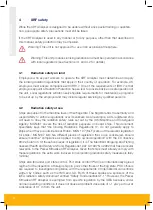
XRF Analyser Manual
5
4.3
Health and safety
The design of the XRF Analyser is consistent with the principles outlined in ISO 12100:2010
(Safety of machinery – General principles for design - Risk assessment and risk reduction).
A risk assessment of the final design has been conducted to highlight actions that should
be taken to minimise operator risk.
Actions
•
Set up a controlled-access area around the instrument.
•
Only allow trained/authorised people to operate the instrument.
•
Carry out a visual inspection of the analyser prior to each use.
•
Use a calibrated radiation monitor to perform annual radiation leak testing.
•
Equip operators with a dosimeter and record cumulative measurements.
•
Review dosage records at regular intervals.
•
Inspect the safety functions (especially the lid interlock, lid release button and
lights) of the analyser prior to use.
•
Prepare local rules that require the unit to be returned in the event of suspected
damage.
•
Maintain the analyser in line with manufacturer guidance.
•
Perform regular electrical testing of the power supply.
•
Protect external cable from damage in use.
•
Do not run the analyser without a sample in place.
•
Use appropriate PPE when handling hazardous samples.
•
Lift the unit only by the integrated handle when necessary.
•
Local rules should state that operators must inform management if they become
pregnant.
•
For absolute safety, redeploy any operator who reports a pregnancy.
•
Keep the XRF in cool, dry conditions.
•
When not in use, the XRF should be stored in a secure location, under lock and
key, to prevent unauthorised access and use. As well as being good practice,
this may be a requirement of local regulations covering the use of ionising
radiation. See sections 4.1 and 4.2 for more details.
Summary of Contents for XRF
Page 1: ...XRF Analyser Instruction manual...
Page 2: ...XRF Analyser Manual...
Page 37: ...XRF Analyser Manual 35...








































